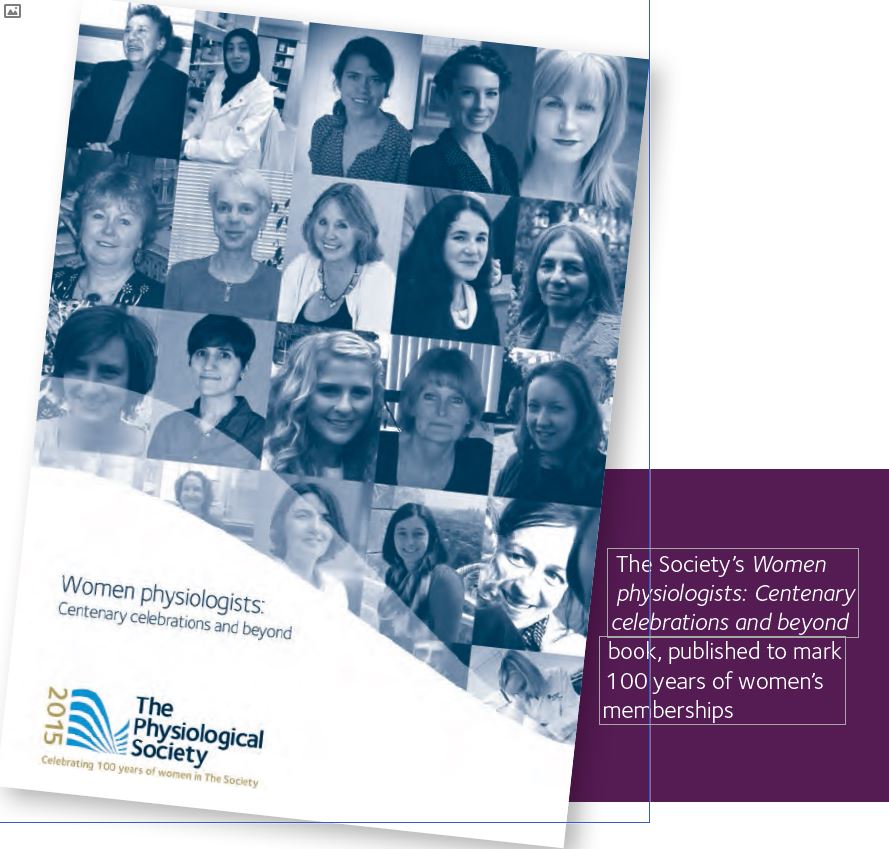
Physiology News Magazine
Celebrating the 100 years of womens’ membership of The Physiological Society
2 December 2015, Hodgkin Huxley House, London, UK
Events
Celebrating the 100 years of womens’ membership of The Physiological Society
2 December 2015, Hodgkin Huxley House, London, UK
Events
Vijay Shankar Balakrishnan,
City University, London, UK
https://doi.org/10.36866/pn.102.15

The year 2015 must have been a triumphant year for women in science, if we look around us, but for women in physiology this is more special. On 2 December 2015, a group of female physiologists gathered at The Physiological Society, situated at Hodgkin Huxley House in London, to celebrate the 100 years of womens’ membership of The Society.
The Society, which has been conducting a series of events throughout the year, commemorating the centenary of women membership, has marked an end to the series with this early winter event last year. Beyond celebration, the physiologists – mostly women and a few men – touched some of the sensitive yet important areas in the politics of doing science.
Soon after the warm welcoming and introduction to the day and the sessions by Professor Susan Wray from the University of Liverpool, the event began with a lecture delivered by Professor Tilli Tansey from Queen Mary, University of London. Tansey’s lecture focussed on the hidden women of the early Physiological Society, with stories on not only female physiologists of those times, but those (house)wives of physiologists, who lit the subject to brightness. The lecture titled, ‘Maud, Nettie, Ghetel and George’ came to a climax when Tansey revealed who George was – she is none other than the writer, George Eliot. The session ended with Tansey being awarded the Paton Prize for her work and the lecture.
Chaired by Professor Susan Wray, the panel of scientists and gender equality advocates discussed whether there is a gender gap in research funding. While Dr Jackie Hunter, Chief Executive at the BBSRC, UK presented the data that the Research Council UK are collecting to determine the gender gap in the research funding in the UK, Professor Kim Barrett from the University of California, San Diego, USA shared her experience across the Atlantic.
Professor Uta Frith from the University College of London put forth not only the data from the Royal Society regarding the gender gap, but also her thoughtful questions on how the problem could be mitigated. The panel with Sarah Dickinson, Head of Equality Charters, Equality Challenge Unit, UK, discussed how initiatives such as Athena Swan SILVER awards help recognise the work of women scientists. The panel came to a consensus that there is not enough data to come to a concrete conclusion to show the magnitude of the gender gap, so more, particularly young female scientists should apply for grants to cement the gap.
After a short break, Dr Barbara Cassadei from the University of Oxford, shared her inspiring work life, and how she managed to balance both work and personal life well, or when sometimes not. One of her take-home messages was ‘choose your partners wisely,’ with which another senior female physiologist, professor emeritus at the University College of London, Dr Lynn Bindmann also agreed. Professor Maria Fitzgerald from the University College of London shared her experience on how to manage work-life balance. Her take-home message was, ‘be brave and bold’ and ‘work hard’.
After a delightful work lunch the event continued with Professor Susan Greenfields talking about how important it is for early career researchers to engage with the public about their science. Her take-home message was that, the scientists should take it as a civil duty to talk to the public and the media, as the politicians get science only through the media. Her inspirational talk captivated the audience also on public speaking and crafting a blockbuster CV.
A parade of young female researchers took to the stage explaining their interesting work in physiology. Each one of them was given only two minutes to talk about their work sans a digital presentation toolkit. All of their works were as inspiring as themselves, with notable examples such as Dr Pooneh Bagher, lecturer at Magdalen College, Oxford, who not only shared her science but also how she survived breast cancer and yet confidently continuing her good work as a scientist and a teacher.
After an in-depth and interesting lecture delivered by Dr Kim Barrett on her complicated and intriguing work on the intersection of physiology and gut microbiology, she was awarded the Bayliss-Starling Prize. She was also announced to be the new editor-in-chief of The Society’s The Journal of Physiology.
The event came to a climax when Richard Vaughan-Jones, President of The Society concluded the scientific events by reiterating and reinforcing the take-home messages from different sessions. The event officially ended when Dr Lynn Bindmann and Professor Tilli Tansey launched the resourceful and inspiring book titled Women physiologists: Centenary celebrations and beyond, which not only has the photos and profiles of female physiologists of different generations, but also their advice to the forthcoming generations, which were all as meaningful as the aim of this event.
